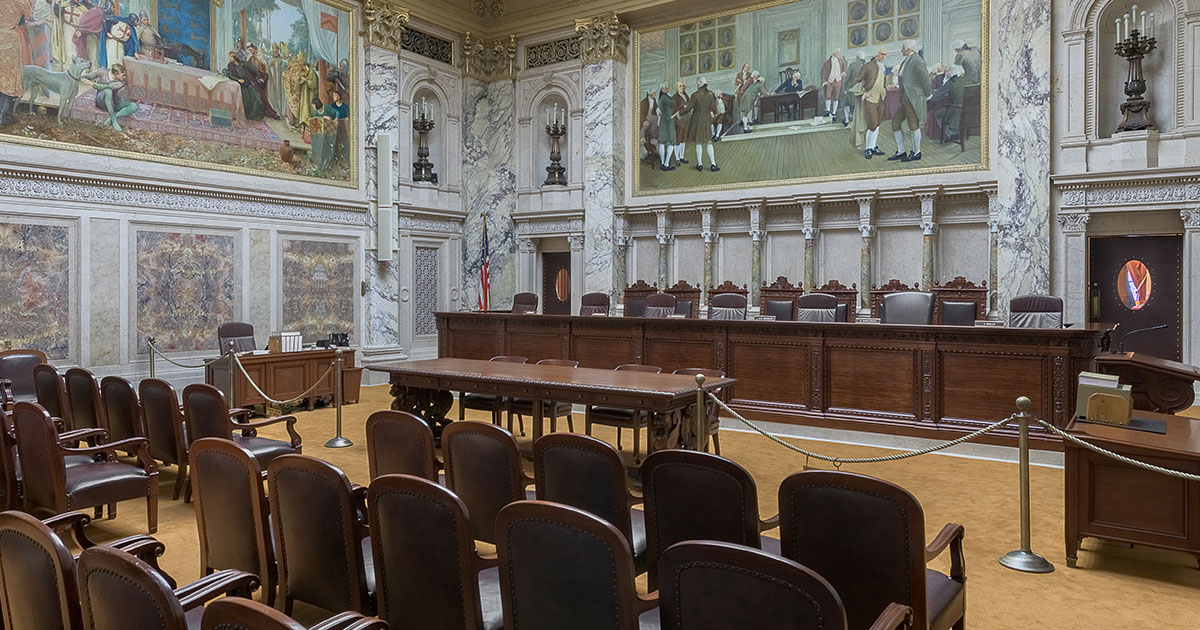
I recently had the privilege to argue a case at the Wisconsin Supreme Court. This was my first supreme court oral argument and an experience I had thought about for some time. In fact, I began kicking around the idea of what it would be like to present oral argument to an appellate court as early as college after being fascinated by a constitutional law seminar. Even though I had no concept at that time about the day-to-day work of an attorney, an appellate oral argument seemed like the pinnacle of law practice – or at least close to it. I knew I wanted that experience someday. It was an honor to have that opportunity relatively early in my legal career. After presenting argument at the court, a friend at the State Bar of Wisconsin suggested I write about my experience in this article.
Initial Preparation
When I first learned I would brief and argue a case at the supreme court, I felt excited, along with the heady pressure that comes with briefing and preparing a case for oral argument. As with so many things in law practice, I knew that preparation was going to be essential. I had to know the record cold, backwards and forwards, and every other direction. The same went for the law. I needed to have a strong command of the authorities that supported my case and those that would be used by the other side.
 J. Wesley Webendorfer, Loyola-Chicago 2012, practices with DeWitt LLP, Madison. His practice focuses on environmental law. He is a member of the State Bar of Wisconsin’s Administrative & Local Government Law and Environmental Law sections.
J. Wesley Webendorfer, Loyola-Chicago 2012, practices with DeWitt LLP, Madison. His practice focuses on environmental law. He is a member of the State Bar of Wisconsin’s Administrative & Local Government Law and Environmental Law sections.
As I began briefing the case, I worked to anticipate questions that might arise from the justices. I developed a running list of those potential questions, including ones specific to my case and those that addressed hypotheticals that would push the limits of my arguments. I wanted to be prepared for anything, even though I knew that the questioning would likely be fast paced and unpredictable. The list of questions I generated proved useful in my preparation and during the argument.
Looking to Quality Examples
Once briefing was complete, there was some downtime before the argument was scheduled. I used that period to think about the performative aspects of arguing the case. I had occasionally watched other attorneys argue cases at the Wisconsin Supreme Court and listened to U.S. Supreme Court arguments. Having proceedings broadcast on WisconsinEye for many years has made accessing Wisconsin Supreme Court arguments straightforward for attorneys and the public. I used WisconsinEye to watch attorneys I admired present their arguments in other cases. I analyzed how those lawyers fielded questions from the justices and how they responded to the points raised by opposing counsel. I took mental notes of what struck me as persuasive, including subtle things such as intonation, inflection, and pace. When a particular moment in those presentations seemed to fall flat with the court, I took note of that too.
Tapping into a Personal Style
Having watched other advocates argue at the court, I began to think about my own presentation style. Did I need to emulate the style of lawyers I admired and found persuasive in other cases? I decided that I should develop and be true to my own style, whatever that was exactly. Too much emulation of another lawyer’s style could backfire and look inauthentic.
I practiced talking out my answers to the possible questions I had prepared. Through that process, I not only refined the substance of the answers, but I also worked to hone my inflection and word choice. As I practiced, I fell into a groove of what seemed natural. That practice gave me the confidence to simply be myself during oral argument.
Creating an Outline
As the oral argument date drew closer, I contemplated that I could not expect to present my case to the justices uninterrupted. Far from it. Oral argument gives the justices the opportunity to ask the tough questions that separate the wheat from the chaff. As Judge Ralph Adam Fine succinctly put it, a primary purpose of oral argument is for justices “to clarify a troubling matter that has chafed at his or her analysis like a pebble in the shoe.”1 Even though I expected to be consistently interrupted at oral argument, I needed an outline of my primary points. The outline would provide a foundation for the presentation that I could return to after answering the justices’ questions. It would also serve as a map to highlight my primary points after directly addressing a particular justice’s direct question.
Mock Arguments and Peer Review
With my outline in hand, I next considered which of my mentors might conduct peer reviews of my planned oral argument. I asked attorneys I trusted and respected to hold two mock arguments. In the first, I went through my presentation uninterrupted, to see what worked and what did not. In the second mock argument, my colleagues played the roles of justices and peppered me with questions. These practice sessions were invaluable for developing both the substance of my argument and the demeanor and tone in which I presented it. The sessions also built my confidence. By the time those mock sessions were complete, I felt as prepared as I could be. I was ready to present the case.
The Day of Argument
I woke up earlier than usual on the day of the oral argument. I live in the Madison area, so there was not a long commute to the State Capitol. For someone less familiar with the Capitol building, inspecting the physical space in the supreme court hearing room is time well spent. Familiarity with the physical space is useful both to ease one’s nerves and to finalize practical logistics of making your presentation. (The supreme court hearing room is also beautiful and intimate. Its history is worth learning about if you have some time to spare.)
My argument was the second of the morning. My partner and I arrived at the court early, and we sat in the gallery and listened to the attorneys in the first case present their arguments. I purposely did not review my outline or the arguments I was about to present. Instead, I tried to relax and control my breathing.
I took a moment to appreciate the grandeur of the hearing room and to briefly reflect on the opportunity to pre-sent the argument. Many people from my family and professional life had helped me reach this point. I took a moment to feel grateful and thankful. I also thought about the advice that my mentors had given me, specifically, that the best appellate arguments are conversational. This was my chance to have a conversation with the justices, albeit a formal one. As I sat and waited for my case to be called, I tried not to think about the proceedings being broadcast live on WisconsinEye or that several of my colleagues and family were there to silently cheer me on. I tried to get in the zone.
Because of my preparation, I felt confident and excited as I stepped to the lectern and adjusted the microphone. Certainly, I also felt nervous, especially until I received my first question. At that point, the conversation with the justices began in earnest as I had prepared for, and I seemed to fall into a groove. Overall, the argument itself was everything I hoped for. It was fun. When the proceeding concluded that day and I walked outside and down the granite Capitol steps, I felt a sense of accomplishment and relief. I also had a desire to have the privilege of arguing before that distinguished body again someday.
Parting Thoughts
Much ink has been spilled about how to prepare for an appellate argument. This column is not intended to break new ground on that front. But from my perspective as a young lawyer, I can say that the key to confidence is significant preparation. That involves seeking out mentors to provide peer review of your arguments. It is vital to ask lawyers whom you trust to provide honest and thoughtful criticism that is not sugarcoated. Once you have command of your best arguments, turn to the performance elements of your case. Develop and present your case in your own style, but learn from lawyers who are more seasoned. Finally, try to have some fun with the preparation and especially at the argument itself.
Endnotes
1 Judge Ralph Adam Fine, Win Your Trial Plus Win on Appeal 108 (1997) (transcript of presentation on file with author).
» Cite this article: 96 Wis. Law. 45-46 (April 2023).
